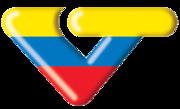Launched August 1, 1964 | Language Spanish Founded 1 August 1964 | |
 | ||
Owned by State-Owned Enterprise under administration of the Ministry of Popular Power for Communication and Information Picture format 480i (4:3 SDTV)1080i (16:9 HDTV) Slogan The Channel of all Venezuelans(Spanish: El Canal de todos los Venezolanos)We Are.....(Spanish: Somos......) Profiles | ||
Corporación Venezolana de Televisión (Spanish for: Venezuelan Television Corporation) or VTV ([beteˈβe]) is a public television network based in Caracas, Venezuela, which can be seen throughout the country on channel eight. Programs that can be seen on VTV include Aló Presidente and Noticias TeleSUR.
Contents
- Private channel 19641974
- State channel 1974 present
- Politics
- Bolivarian government
- Slogan
- Presidency
- References
VTV has produced a number of telenovelas, including titles such as Ifigenia, Doña Perfecta, and La Dueña. 1984's La Dueña was perhaps its most successful and popular production. In 2004, VTV produced another telenovela, Amores de Barrio Adentro, but it was only seen once a week and lasted only a few months. In August 2014, VTV celebrated its 50th anniversary.
Private channel (1964–1974)
Cadena Venezolana de Televisión (CVTV) was inaugurated as a privately owned television station on August 1, 1964, at 7:30 p.m. President Raúl Leoni was chosen to be the one to cut the ribbon. Despite its name, however, it was not a nationwide television network at first, broadcasting in the Caracas area during its first years. Only in the late 1960s did the channel become a national network with the opening of stations in major cities nationwide, and became the first network to produce and broadcast a color program in 1971.
State channel (1974 - present)
In September 1974, CVTV, after prolonged financial problems due to its competition with the better-established privately owned television networks in Venezuela, Radio Caracas Televisión and Venevisión, was purchased by the Venezuelan government and rebranded as Venezolana de Televisión (VTV). Between 1974 and 1980, VTV was funded in whole by the government, but due to an internal economic crisis, VTV was forced to air advertisements for extra revenue (this has no longer been occurring since Hugo Chávez became president in 1999). It now only broadcasts program previews and government ads instead.
After June 1, 1979, VTV, as well as the other television networks in Venezuela, were allowed, by the government of President Luis Herrera Campins, to transmit completely in color using the NTSC-M system. By 1980, the transition was complete, and VTV was then rebranded as the VTV Network (VTV Red) until 1982, together with Televisora Nacional, the other state-owned television channel in Venezuela and the first television station to be established, thus briefly uniting channels 5 and 8 into one national network.
In 1990, VTV, after a government decision to close the Televisora Nacional due to the economic situation of the country, began simulcasting on channel 5, system M, color NTSC. This simulcast lasted until December 4, 1998, when the government handed over the signal of channel five to the Archbishopric of Caracas, which gave birth to Vale TV.
In 1999, VTV used a logo identical to the nicknamed "Exploding Pizza" ident used by the Canadian Broadcasting Corporation. In 2011, they began to broadcast Formula 1, and by 2014, became the first Latin American station to broadcast Russia's RT Actualidad's newscast.
Politics
VTV has several times been targeted during coup attempts. VTV was a target in the 27 November 1992 coup attempt. Military officers, in rebellion against President Carlos Andrés Pérez, attacked the station, and ten station employees were killed.
Bolivarian government
A 2006 study based on four days’ programming alleged that during the presidency of Hugo Chávez, VTV has been used by the government as an instrument to campaign against Venezuela's opposition and Venezuela's privately owned media. On the evening of the 11 April 2002 coup attempt against Chávez, Enrique Mendoza, then governor of Venezuela's Miranda State, while being interviewed by Venevisión announced "a esa basura de canal la vamos a cerrar" ("We are going to shut down that trashy channel"), referring to VTV. Hours later, the Miranda state police occupied VTV and forced it off the air. It remained off the air until April 14, 2002, when Chávez was returned to power.
During the Venezuelan general strike of 2002–03, VTV would share ads depicting Venezuelans waiting in line for gas canisters with a voice saying "The opposition unleashed terrorism on the Venezuelan people and it led to hunger and unemployment. Thanks to the new PDVSA, PDVSA is for all of us, all of us are PDVSA". VTV would also alter images of pro-government rallies to make them appear larger and used outdated videos to attack opposition members or former supporters. In February 2004, the president of state television station Venezolana de Television (VTV) stated that VTV was not a state television station but a station of President Chávez's political party. VTV also aired ads showing the September 11 attacks, comparing them to the opposition stating "The people know who the terrorists are". In 2005, the program Dossier was cancelled after its host and producer, Walter Martinez, accused the government of corruption.
Slogan
VTV's slogan is "El Canal de todos los Venezolanos", or "The channel of all Venezuelans". It had changed temporarily to "Desde adentro", or "From inside" but it has since been changed back.
